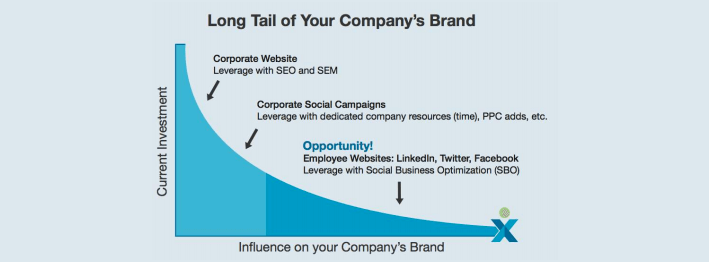In this episode, I speak with Michael Idinopulos, Chief Marketing Officer at PeopleLinx, a social marketing software provider and Gartner Cool Company award recipient. We discussed key take aways from an e-book Michael co-authored with Neal Schaffer titled: How to Build an Employee Advocacy Program.
Companies have traditionally used social media to broadcast messages, mostly from the marketing department. That’s no longer new and no longer as effective as it was a year or two ago. Employee Advocacy is about working with your employees to help them tell your story on behalf of the brand. Essentially, it’s an extension of “everyone’s in sales,” made possible by a social culture and a social mindset. Employee advocacy is rapidly emerging as a new category in modern business strategy.
Reach and Trust
Brands have limited reach in and of themselves. Consider that a company may have hundreds or thousands of people it can reach. Employees can reach more people based on their network across multiple social channels. Regarding trust, it’s proven that 84% trust recommendations from people they know, but only 15% trust recommendations from brands. This is merely an extension of the history of business, people doing business with people. A phenomenon we can all understand is how most of us commonly trust product reviews online by people we don’t know when the review has been written in a relevant manner that relates to our needs. This is both an example of reach and trust.
The Long Tail of a Brand
A company’s brand is influential to a large number of people with a few assets such as the company website, the company blog, social media channels, advertising media, etc. Some of these assets reach a smaller number of people. The employees represent the long tail with the ability to reach people across social media channels per employee reaching a finite number of people with multiple digital assets for each employee.
Source: Neal Schaffer & PeopleLinx e-book: How to Build an Employee Advocacy Program
Employee Advocacy Special Benefit for Sales
Establish, Build, Promote, Listen, Measure
Customer facing employees have a special set of activities that are improved by social behavior starting with establishing credibility. A Google search for a person’s name will likely return their LinkedIn profile and Twitter handles first. The first and most important benefit is the opportunity to establish credibility with strong profiles in both social channels.
Employees should build relevant networks with the people that matter to you in your business. If employees are not connected to the right people, your message isn’t getting to the right people. Helping employees expand their network of relevant connections is a wise best practice. Promoting thought leadership positions that employee to be top of mind when someone has a need. Employees should be taught to listen for opportunities, to engage to create relevant connections and to create relevant experiences. Lastly, measuring the social activities of employees helps to determine the impact of employee advocacy. Measuring click throughs on content, engagement levels, new opportunities, new relationships established, etc., allow a brand to measure business results from employee advocacy.
Defining an Employee Advocacy Strategy
It starts at the top of the traditional sales funnel.
Brand Awareness
Are you getting new followers, click throughs, traffic from organic search results?
Lead Generation
Are you attracting leads as a result of touches of social behavior?
New Customer
Are close rates increasing as their social activity increases? Are reps who are active on social closing more than those who aren’t? Look for a clear line between social activity, qualified leads and customer acquisition.
The Three I’s
Internal Support
Senior executive support is imperative. When executives embrace and champion an employee advocacy program, they must walk the walk. It’s starts with a clean LinkedIn profile, weekly activity on LinkedIn and Twitter demonstrating thought leadership. This activity sends a clear message to employees that the activity is encouraged and expected of them. It also sets an example of how it should be done.
Infrastructure
Employee Advocacy is a strategy that needs a formal process with infrastructure. It needs a social media policy with guidelines for employees to follow. It needs training. And, it need tools and technology to empower employees to strengthen their profiles, expand their network and enable content sharing. And, tools should provide the ability to measure the impact of an Employee Advocacy program. Said otherwise, an Employee Advocacy program without infrastructure will probably fade the same as any other business initiative that requires infrastructure.
Incentive
Provide employees with an incentive to be an employee advocate. Some examples include providing a badge, or public recognition, or a designated parking spot or even a certificate if you offer a formal training program. Of course, the incentive you choose to offer should align with the culture of your business.
Measuring success
The e-book How to Develop an Employee Advocacy Program provides a visually compelling table for operational metrics for an Employee Advocacy program on page 11.
Evolving Relationship between Marketing and Sales
Until just a few years ago, only the marketing department could market. Only marketing could publish and promote. Social has changed that. Now, anyone in the company can engage as a representative of the brand. Now, everyone is in marketing. Now, salespeople can do more marketing. And, marketing’s role is changing. Increasingly as more employees are marketing, the role of marketing is to be a coach. To provide messaging guidelines, the materials, best practices and provide support and assistance. Marketing’s role is to make the employee’s advocacy as effective as possible.
It should be clear by now that employee advocacy is not just for sales reps. By empowering the entire employee base on social business best practices, companies can exponentially increase the size of their “social selling” channel. From the C-Suite to Product Development to Customer Service, we all have a voice.
One Thing
You’re going to love Michael’s response to my “one thing” question. Michael encourages people to have fun while conducting business. To hear his full explanation of how we can have more fun in business, listen to my podcast recording with him….




